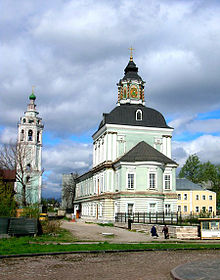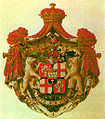Demidow (noble family)



Demidow also Demidoff di San Donato and Lopuchin-Demidow ( Russian Демидов ) is the name of a widespread Russian noble family that rose from Russian industrialists to Tuscan and Russian titular princes . The family produced numerous philanthropists , patrons , and patrons of art and science.
history
The progenitor of the family was Demid Antufjew, a blacksmith in Pawschino near Tula , whose son Nikita Demidowitsch Antufjew (1656–1725) had the first iron foundry built in the Urals as a blacksmith or hammer smith in the city of Nevyansk near Yekaterinburg in 1699 on behalf of the Russian government . As a thank you for Antufiev's skillful and profitable administration, Emperor Peter the Great elevated him to the Russian personal nobility on September 21, 1720 under the family name Demidow and in 1702 gave him the iron foundry he had built. In 1725 Demidow sent miners to Siberia who discovered gold, silver and other ore deposits in the Altai Mountains, the yield of which established the extraordinary wealth of his family. His son Akinfi Nikititsch Demidow (1678-1745) was able to develop the family business into the so-called Demidow empire at its peak. He received on March 24, 1726 together with his brothers Grigori Nikititsch Demidow and Nikita Nikititsch Demidow (1628-1804) the hereditary nobility. Under his three sons Prokofi Demidow (1710–1786), Grigori Demidow (1715–1786) and Nikita Demidow (1724–1789) an inheritance dispute broke out, which was finally decided by the Empress Elisabeth Petrovna . The sons were compensated, while the conglomerate of the Demidow works went to the state. All three brothers continued the lineage .
The family subsequently provided numerous Imperial Russian court officials and councilors as well as generals in the Russian army , but also continued to be active in mining and metallurgy, which was the basis for their wealth and the extensive foundations that emanated from them. Today's Yaroslavl State University - PG Demidow is named after its founder Pawel Grigoryevich Demidow (1738–1821), who had it set up as a college for higher sciences in 1803.
Alexander Demidow had his brother-in-law Ivan Starow build a representative mansion near Gatchina from 1773–1776 . His brother Nikolai Nikititsch Demidow (1773–1828) brought numerous German officials and miners into the country to optimize the management of his industry. He lived for a long time in Paris and Florence and, with princely generosity, was a great benefactor, patron and promoter of science and art. In 1815 he became the imperial Russian ambassador in Florence, acquired the fiefdom of San Donato and was elevated to the rank of count on February 23, 1837 by Grand Duke Leopold II in recognition of his services according to the principle of primogeniture . His two sons Pawel Nikolajewitsch Demidow (1798-1840) and Anatole Demidoff di San Donato (1813-1870) emerged from his marriage to Baroness Jelisaweta Alexandrowna Stroganowa (1779-1818) . Together they owned around 1,000,000 hectares of land in the Urals . The older son, Pavel Nikolajewitsch Demidow, was also an outstanding philanthropist of his time. Among other things, he sponsored the St. Petersburg Academy of Sciences , from which it awards the Demidow Prize annually from 1831 to 1865 (and again from 1993) .
Demidoff di San Donato
Also Anatol Demidov (1813-1870) was a big industrialist, a promoter of science and art. He was promoted to the rank of prince in Tuscany on October 20, 1840 in Florence. As an imperial Russian chamberlain , he was registered on the imperial recommendation in 1842 under no. 53 for the Estonian knighthood and under no. 386 in the revised registers, also from 1842, each as an honorary member of the Livonian knighthood . In 1840 he married Mathilde Bonaparte (1820–1904), a niece of Napoleon . Since this connection remained childless, his title of prince was transferred to his nephew Paul Demidow (1839-1885), who continued the lineage, on March 15, 1848. On January 14, 1872, the title of prince was renewed for the same according to the principle of primogeniture. Only then did Russia grant permission to use the title abroad. The status of princes was still not recognized within Russia. The prince title was extended to all male relatives in Rome on March 2, 1884, but with retention of the predicate di San Donatao in the primogeniture. The unrestricted expansion took place on December 31, 1884.
Princess Aurora Paulowna Demidoff (1873–1904) was married to Arsen Karađorđević, Prince of Yugoslavia (1859–1938). So she was the sister-in-law of the Yugoslav king and mother of the Prince Regent of Yugoslavia , Paul of Yugoslavia (1893-1976). With her brother Anatole Demidoff , the 4th Prince of San Donato (1874–1943), the male line of this line became extinct.
Lopukhin-Demidov
The Imperial Russian Lieutenant General Nikolai Petrovich Demidow (1836–1910), son of the Imperial Russian Lieutenant General Pyotr Grigoryevich (1807–1862) and grandson of Princess Jekatarina Petrovna Lupochina (1783–1830), heiress of Tanzij near St. Petersburg , was born on 21. On January 1st, 1876 in St. Petersburg he was promoted to the rank of Russian prince on the principle of primogeniture. The princely line he founded was continued in Finland by his grandson, Prince Aleksandr Aleksandrovich Lopuchin-Demidow (1905-1939) .
coat of arms
The ancestral Arms (1726) is by a golden beam divided and shows up in silver three chevron-shaped green hut tools side by side, down in black and a silver miner mallets. On the helmet with green and silver covers a green tuft of leaves.
The prince's coat of arms (1840) is quartered with a black cross and covered with a crossed heart shield (family coat of arms), 1 and 4 in red a Florentine silver lily , 2 and 3 in silver a red Greek cross (coat of arms of the municipality of Florence). On the helmet with red and gold covers on the right and black and silver covers on the left, two set miner's mallets. Shield holder : two inward-facing natural Russian bears ; Motto : Acta non verba ; Princely hat and coat.
Relatives
- Nikita Demidow (1656–1725), Russian industrialist
- Akinfi Nikititsch Demidow (1678–1745), Russian industrialist
- Prokofi Akinfijewitsch Demidow (1710–1786), Russian industrialist, botanist and patron
- Grigori Akinfijewitsch Demidow (1715–1761), Russian entrepreneur, botanist and patron
- Nikita Akinfijewitsch Demidow (1724–1789), Russian entrepreneur and patron
- Alexander Grigoryevich Demidow (1737–1803), Russian entrepreneur
- Pawel Grigoryevich Demidow (1739-1821), Russian private scholar
- Pyotr Grigoryevich Demidow (1740–1826), Russian entrepreneur
- Nikolai Iwanowitsch Demidow (1771–1833), Russian infantry general
- Nikolai Nikititsch Demidow (1773–1828), Russian industrialist
- Pawel Nikolajewitsch Demidow (1798-1840), Russian industrialist, real councilor and governor of Kursk
- Pyotr Grigoryevich Demidow (1807–1862), Russian lieutenant general
- Pawel Grigoryevich Demidow (1809-1858), Russian Real State Councilor and Governor of Kursk
- Anatole Demidoff di San Donato (1813–1870), Russian industrialist
- Nikolai Petrovich Lopuchin-Demidow (1836–1910), Russian lieutenant general
- Grigori Aleksandrovich Demidow (1837–1870), Russian composer
- Pawel Pawlowitsch Demidow di San Donato (1839–1885), 1871–1876 mayor of Kiev
- Michael Denissowitsch Demidow (1840–1898), Russian Real Councilor of State and Governor of Olonetz
Portraits
Nikita Demidow (1656-1725)
Akinfi Nikititsch Demidow (1678-1745)
Prokofi Akinfijewitsch Demidow (1710–1786)
Grigori Akinfijewitsch Demidow (1715–1761)
Nikita Akinfijewitsch Demidow (1724–1789)
Alexander Grigoryevich Demidow (1737-1803)
Pawel Grigoryevich Demidow (1739-1821)
Nikolai Nikititsch Demidow (1773-1828)
Pawel Nikolajewitsch Demidow (1798-1840)
Anatole Demidoff di San Donato (1813–1870)
Paul Demidoff di San Donato (1839-1885)
literature
- Genealogisches Handbuch des Adels Adelslexikon Volume II, Volume 58 of the complete series, CA Starke Verlag , Limburg / Lahn 1974, pp. 452–453; Volume XVII, Supplements , Volume 144 of the complete series, 2008, p. 180
- Gothaisches Genealogisches Taschenbuch der Fürstlichen Häuser , Justus Perthes , Gotha 1908, pp. 425–426 (continuations until 1941, each article by San Donato )
- Detlev Schwennicke (Ed.): European Family Tables New Series , Volume IX: Families of Early and High Capitalism . Verlag Vittorio Klostermann , Frankfurt Main 1984, panels 20-23
Web links
- Demidow family (Canada) (English)
- The Demidov (English)
- History of the Demidow family on the website of Demidow University in Yaroslavl (Russian)
- History of the Demidov family (English)
- Международный Демидовский фонд ( International Demidow Foundation ) (Russian)
- Stammlinie Demidow (English)
Individual evidence
- ↑ Genealogical Handbook of the Baltic Knights , Görlitz 1930, p. 303.
- ↑ Anatole and Mathilde: History of their marriage (English)

















